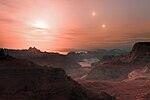Kepler-56 is a red giant[6] in constellation Cygnus roughly 3,030 light-years (930 pc) away[4] with slightly more mass than the Sun.
Characteristics
Kepler-56 is a red giant star. This means it is no longer fusing hydrogen in its core and is off the main sequence. Its mass is around 1.3 M⊙. Its radius is about 4.2 R⊙, putting the star's density at about 0.025 g/cm3. For reference, the Sun's density is about 1.408 g/cm3. Its metallicity is about 0.0251 Z0/X0. Its luminosity is about 9.6 L⊙, and its effective temperature is 4,973 K (4,700 °C; 8,492 °F), classifying Kepler-56 as spectral class K3III.[5]
Kepler-56 is about 3.9 billion years old,[5] placing it as about 600 million years younger than our Sun. Its apparent magnitude is +13, making it too dim to be visible to the naked eye.
Planetary system
In 2012, scientists discovered a two-planet planetary system around Kepler-56 via the transit method. Asteroseismological studies revealed that the orbits of Kepler-56b and Kepler-56c are coplanar but about 45° misaligned to the host star's equator. In addition, follow-up radial velocity measurements showed evidence of a gravitational perturbator.[6] It was confirmed in 2016 the perturbations are caused by third, non-transiting planet: Kepler-56d.[7]
The planetary system is very compact but is dynamically stable.[8]
Kepler-56 is expanding. As a result, it will devour Kepler-56b and Kepler-56c in 130 and 155 million years, respectively.[9][10] 56d will be far enough to survive its parent star's red giant phase.
| Companion (in order from star) |
Mass | Semimajor axis (AU) |
Orbital period (days) |
Eccentricity | Inclination | Radius |
|---|---|---|---|---|---|---|
| b[2][11] | 22.25344 M🜨 | 0.1028 | 10.5034294 | — | 79.640° | 3.606495320 R🜨 |
| c[3][12] | 0.569 MJ | 0.1652 | 21.4050484 | — | 81.930° | 7.844702558 R🜨 |
| d[7] | >5.61±0.38 MJ | 2.16±0.08 | 1002±5 | 0.20±0.01 | — | — |
References
- ^ a b c "Kepler-56". SIMBAD. Centre de données astronomiques de Strasbourg.
- ^ a b "Planet Kepler-56 b". Extrasolar Planets Encyclopaedia. Retrieved 2013-10-18.
- ^ a b "Planet Kepler-56 c". Extrasolar Planets Encyclopaedia. 2018.
- ^ a b c d e Vallenari, A.; et al. (Gaia collaboration) (2023). "Gaia Data Release 3. Summary of the content and survey properties". Astronomy and Astrophysics. 674: A1. arXiv:2208.00211. Bibcode:2023A&A...674A...1G. doi:10.1051/0004-6361/202243940. S2CID 244398875. Gaia DR3 record for this source at VizieR.
- ^ a b c d Fellay, L.; Buldgen, G.; et al. (October 22, 2021). "Asteroseismology of evolved stars to constrain the internal transport of angular momentum". Astronomy & Astrophysics. 654. 12. arXiv:2108.02670. doi:10.1051/0004-6361/202140518. S2CID 239652877. Retrieved March 30, 2022.
- ^ a b Huber, Daniel; Carter, Joshua; et al. (October 21, 2013). "Stellar Spin-Orbit Misalignment in a Multiplanet System". Science. 342 (6156): 331–334. arXiv:1310.4503. Bibcode:2013Sci...342..331H. doi:10.1126/science.1242066. PMID 24136961. S2CID 1056370.
- ^ a b Otor, Oderah Justin; Montet, Benjamin T.; et al. (22 September 2016). "The Orbit and Mass of the Third Planet in the Kepler-56 System". The Astronomical Journal. 152 (6). Cornell University: 165. arXiv:1608.03627v2. Bibcode:2016AJ....152..165O. doi:10.3847/0004-6256/152/6/165. ISSN 0004-6256.
- ^ Denham, Paul; Naoz, Smadar; et al. (29 October 2018). "Hidden planetary friends: on the stability of two-planet systems in the presence of a distant, inclined companion". Monthly Notices of the Royal Astronomical Society. 482 (3): 4146–4154. arXiv:1802.00447. doi:10.1093/mnras/sty2830. ISSN 0035-8711.
- ^ Kramer, Miriam (June 10, 2014). "Chow Down! Star Will Devour 2 Alien Planets". Space.com. Retrieved 24 February 2022.
- ^ Li, Gongjie; Naoz, Smadar; et al. (October 1, 2014). "The Dynamics of the Multi-planet System Orbiting Kepler-56". The Astrophysical Journal. 794 (2): 131. arXiv:1407.2249. Bibcode:2014ApJ...794..131L. doi:10.1088/0004-637X/794/2/131. S2CID 56224888.
- ^ "KOI-1241.02 -- Extra-solar Confirmed Planet". SIMBAD.
- ^ "KOI-1241.01 -- Extra-solar Confirmed Planet". SIMBAD.
External links

















You must be logged in to post a comment.